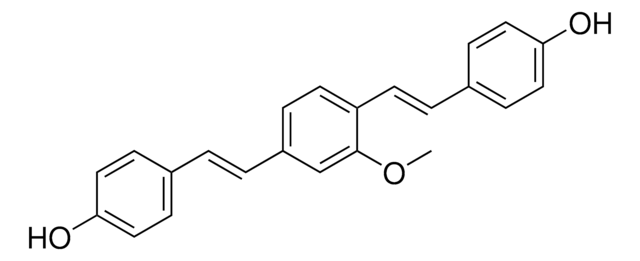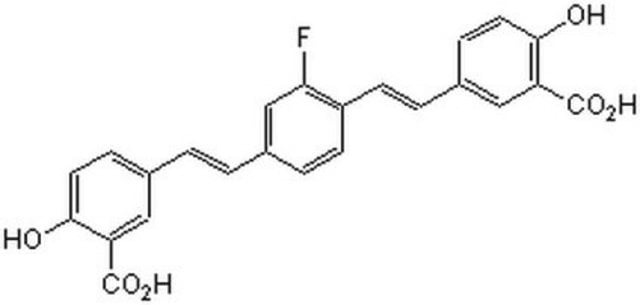SML1954
X-34
≥90% (HPLC), powder, amyloid-specific fluorescent dye
Synonym(s):
1,4-Bis(3-carboxy-4-hydroxyphenylethenyl)benzene
Sign Into View Organizational & Contract Pricing
All Photos(1)
About This Item
Empirical Formula (Hill Notation):
C24H18O6
CAS Number:
Molecular Weight:
402.40
MDL number:
UNSPSC Code:
12352200
NACRES:
NA.77
Recommended Products
product name
X-34, ≥90% (HPLC)
Quality Level
Assay
≥90% (HPLC)
form
powder
color
white to beige
solubility
DMSO: 2.0 mg/mL, clear
storage temp.
2-8°C
SMILES string
OC(C=C1)=C(C(O)=O)C=C1C=CC2=CC=C(C=CC3=CC=C(O)C(C(O)=O)=C3)C=C2
Biochem/physiol Actions
Fluorescent, amyloid-specific dye
X-34 (1,4-bis(3-carboxy-4-hydroxyphenylethenyl)-benzene) is one among the small-molecule γ-secretase modulators (GSMs) involved in lowering Aβ42 levels (the 42-residue isoform of the amyloid-β peptide). X-34 has also been used to visualize intracellular immunoreactive deposits with classic amyloid fibrillar ultrastructure in living transgenic Caenorhabditis elegans animals. It is also used as a histochemical stain for determining pathological changes in Alzheimer′s disease (AD).
X-34 is a fluorescent, amyloid-specific dye. It binds at a different site than Pittsburgh Compound B and is a highly fluorescent marker for beta-sheet structures.
Storage Class Code
11 - Combustible Solids
WGK
WGK 3
Flash Point(F)
Not applicable
Flash Point(C)
Not applicable
Certificates of Analysis (COA)
Search for Certificates of Analysis (COA) by entering the products Lot/Batch Number. Lot and Batch Numbers can be found on a product’s label following the words ‘Lot’ or ‘Batch’.
Already Own This Product?
Find documentation for the products that you have recently purchased in the Document Library.
Visualization of fibrillar amyloid deposits in living, transgenic Caenorhabditis elegans animals using the sensitive amyloid dye, X-34
Link CD
Neurobiology of Aging, 22, 217-226 (2001)
Taweesak Tangrodchanapong et al.
Molecules (Basel, Switzerland), 26(8) (2021-05-01)
The pathological finding of amyloid-β (Aβ) aggregates is thought to be a leading cause of untreated Alzheimer's disease (AD). In this study, we isolated 2-butoxytetrahydrofuran (2-BTHF), a small cyclic ether, from Holothuria scabra and demonstrated its therapeutic potential against AD
S D Styren et al.
The journal of histochemistry and cytochemistry : official journal of the Histochemistry Society, 48(9), 1223-1232 (2000-08-19)
X-34, a lipophilic, highly fluorescent derivative of Congo red, was examined as a histochemical stain for pathological changes in Alzheimer's disease (AD). X-34 intensely stained neuritic and diffuse plaques, neurofibrillary tangles (NFTs), neuropil threads, and cerebrovascular amyloid. Comparison to standard
Andy P Tsai et al.
Neurobiology of disease, 153, 105303-105303 (2021-02-26)
Alzheimer's disease (AD) is a progressive neurodegenerative disorder characterized by cognitive decline, robust microgliosis, neuroinflammation, and neuronal loss. Genome-wide association studies recently highlighted a prominent role for microglia in late-onset AD (LOAD). Specifically, inositol polyphosphate-5-phosphatase (INPP5D), also known as SHIP1
Substrate-targeting ?-secretase modulators
Kukar TL
Nature, 453, 925-929 (2008)
Our team of scientists has experience in all areas of research including Life Science, Material Science, Chemical Synthesis, Chromatography, Analytical and many others.
Contact Technical Service








